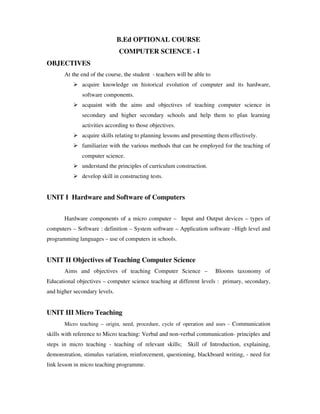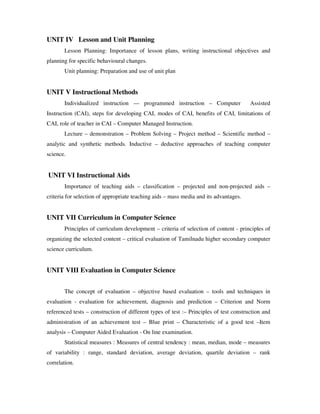Comp i
- 1. B.Ed OPTIONAL COURSE COMPUTER SCIENCE - I OBJECTIVES At the end of the course, the student - teachers will be able to acquire knowledge on historical evolution of computer and its hardware, software components. acquaint with the aims and objectives of teaching computer science in secondary and higher secondary schools and help them to plan learning activities according to those objectives. acquire skills relating to planning lessons and presenting them effectively. familiarize with the various methods that can be employed for the teaching of computer science. understand the principles of curriculum construction. develop skill in constructing tests. UNIT I Hardware and Software of Computers Hardware components of a micro computer ŌĆō Input and Output devices ŌĆō types of computers ŌĆō Software : definition ŌĆō System software ŌĆō Application software ŌĆōHigh level and programming languages ŌĆō use of computers in schools. UNIT II Objectives of Teaching Computer Science Aims and objectives of teaching Computer Science ŌĆō Blooms taxonomy of Educational objectives ŌĆō computer science teaching at different levels : primary, secondary, and higher secondary levels. UNIT III Micro Teaching Micro teaching ŌĆō origin, need, procedure, cycle of operation and uses - Communication skills with reference to Micro teaching: Verbal and non-verbal communication- principles and steps in micro teaching - teaching of relevant skills; Skill of Introduction, explaining, demonstration, stimulus variation, reinforcement, questioning, blackboard writing, - need for link lesson in micro teaching programme.
- 2. UNIT IV Lesson and Unit Planning Lesson Planning: Importance of lesson plans, writing instructional objectives and planning for specific behavioural changes. Unit planning: Preparation and use of unit plan UNIT V Instructional Methods Individualized instruction ŌĆōŌĆō programmed instruction ŌĆō Computer Assisted Instruction (CAI), steps for developing CAI, modes of CAI, benefits of CAI, limitations of CAI, role of teacher in CAI ŌĆō Computer Managed Instruction. Lecture ŌĆō demonstration ŌĆō Problem Solving ŌĆō Project method ŌĆō Scientific method ŌĆō analytic and synthetic methods. Inductive ŌĆō deductive approaches of teaching computer science. UNIT VI Instructional Aids Importance of teaching aids ŌĆō classification ŌĆō projected and non-projected aids ŌĆō criteria for selection of appropriate teaching aids ŌĆō mass media and its advantages. UNIT VII Curriculum in Computer Science Principles of curriculum development ŌĆō criteria of selection of content - principles of organizing the selected content ŌĆō critical evaluation of Tamilnadu higher secondary computer science curriculum. UNIT VIII Evaluation in Computer Science The concept of evaluation ŌĆō objective based evaluation ŌĆō tools and techniques in evaluation - evaluation for achievement, diagnosis and prediction ŌĆō Criterion and Norm referenced tests ŌĆō construction of different types of test :ŌĆō Principles of test construction and administration of an achievement test ŌĆō Blue print ŌĆō Characteristic of a good test ŌĆōItem analysis ŌĆō Computer Aided Evaluation - On line examination. Statistical measures : Measures of central tendency : mean, median, mode ŌĆō measures of variability : range, standard deviation, average deviation, quartile deviation ŌĆō rank correlation.
- 3. UNIT IX Text Books Qualities of good computer science text book ŌĆō use of text book in and outside the classroom ŌĆō criteria for evaluation of computer science text book ŌĆō value of the computer science library. UNITX Assignment and Review Assignment ŌĆō types ŌĆō need ŌĆō characteristics of good assignment ŌĆō correction ŌĆō review ŌĆō characteristics of a good review ŌĆō need and importance of reviewing lesson. PRACTICALS : Practice of a minimum of three skills on micro teaching Preparation of Lesson plan and Unit plan Preparation of teaching aids Preparation of Programmed Instruction Linear Programming (Minimum of 20 frames) Multimedia Presentation (Minimum of 20 slides) Preparation of transparencies Construction of an achievement test Critical analysis of content course of standard IX to XII syllabus. Identification and cataloguing of three websites relating to the prescribed school curriculum Comparative evaluation of any two web pages bearing on the same unit in the school curriculum SUGGESTED REFERENCE BOOKS: Singh,Y. K. (2009). Teaching Practice. New Delhi: APH Publishing Corporation. Sharma, R. N. (2008). Principles and Techniques of Education. Delhi: Surjeet Publications. Sharma, R. A. (2008). Technological foundation of education. Meerut: R.Lall Books. Depot Agarwal J. C. (2006). Essential of educational technology. Teaching and learning. New Delhi: Vikas Publishing House Pvt. Ltd. :
- 4. ! " : # ! & ! $# : ! & " % " : & ! ! ' ( ) ! ( $## ) Mohanty, L. (2006). ICT strategies for schools. New Delhi: Sage Publication. Sambath, K., Paneerselvam, A., & Santhanam, S. (2006). Introduction of educational technology. New Delhi: Sterling Publishers Private Limited. Sidhu, K. S. (2006). Teaching of mathematics. New Delhi: Sterling Publishers Private Ltd. Vanaja, M. (2006). Educational technology. Hyderabad: Neelkamal Publications Pvt. Ltd. Goel, H. K. ( 2005). Teaching of Computer Science. New Delhi: R.Lall Book Depot. Krishnamurthy, R. C. (2003). Educational technology: Expanding our vision. Delhi: Authors Press. Srinivasan, T. M. (2002). Use of computers and multimedia in education. Jaipur: Aavisakar Publication. Alexis, M. L. (2001). Computer for every one. Leon: Vikas Publishing house Ltd: New Delhi. Norton, P. (1998). Introduction to computers. New Delhi: Tata McGraw Hill Publishing Co Ltd. Sharma, R. C. (1998). Modern science teaching. New Delhi: Dhanpat Raj and Sons. Kumar, K. L. (1997). Educational technology. New Delhi: Angel International (P) Ltd. Stone, E. (1996). How to use microsoft access. California: Emergyville. Kochhar, S. K. (1992). Methods and techniques of teaching. New Delhi: Sterling Publishers Pvt Ltd. Oosterhof, A. C. (1990) . Classroom applications of educational measurement. Ohio: Merrill Publishing. Chauhan, S. S. (1985). Innovations in teaching learning process. New Delhi: Vikas Publishing house Ltd. Stephen, M. A., & Stanely, R. (1985). Computer based instruction: Methods and development. NJ: Prentice Hall.
- 5. Balaguruswamy. E., & Sharma, K. D. (1983). Computer in education and training. New Delhi: NIIT. Garrett, H. E. (1979). Statistics in psychology and education. Bombay: Vakils, Feffer and Simons Ltd. Passi, B. K. (1976). Becoming a better teacher : Micro teaching approach. Ahemedabad : Sahitya Mudranalaya,. Passi, B. K. (1976). Becoming a better teacher : Micro teaching approach. Ahemedabad: Sahitya Mudranalaya.





